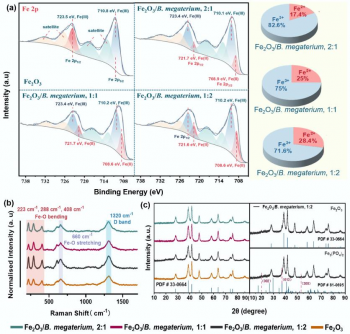Science
Innovative Solar-Powered Biofilms Tackle Soil Pollution Effectively

A recent study has unveiled a groundbreaking method for addressing soil and groundwater pollution using solar-powered biofilms. Conducted by researchers led by Bo Pan and Baoshan Xing from Kunming University of Science and Technology and the University of Massachusetts, the research focuses on the degradation of harmful antibiotics, such as tetracycline hydrochloride (TCH) and chloramphenicol (CPL), through innovative biophotoelectrochemical processes.
The study, published on September 15, 2025, in the journal Environmental and Biogeochemical Processes, highlights how non-phototrophic microorganisms can harness solar energy via interactions with iron minerals in soil and sediments. This discovery expands the understanding of how sunlight influences microbial metabolism, even in environments where light penetration is minimal.
By exploring the interactions between iron minerals, specifically Fe2O3 and FeOOH, and the bacterium Bacillus megaterium, the researchers identified a mechanism that enhances the degradation of pollutants. This co-culturing system operates through continuous charge-discharge cycles, demonstrating a unique “photovoltaic memory” effect that enhances pollutant degradation efficiency.
The study revealed a notable difference in charge accumulation during light and dark cycles. The total accumulated charge, measured as ∑σ, increased with higher densities of B. megaterium biofilms, indicating that denser microbial populations enhance charge capture and storage. Specifically, the net accumulated charge rose from 2.87 μC·cm−2 to 4.08 μC·cm−2 over several cycles, showcasing the system’s efficiency.
Following exposure to light, the degradation efficiency of TCH and CPL improved significantly—by 66.7% and 46.7%, respectively. This enhancement is attributed to the synergistic interactions between iron minerals and the bacteria, facilitating efficient electron transfer and enabling the system to act as a “biological capacitor.”
The implications of this research are profound. The findings suggest that the Fe2O3/B. megaterium biofilm system could revolutionize bioremediation practices, particularly for treating antibiotic-contaminated environments. With the capability to store and release energy for pollutant degradation in dark zones, this approach offers a cost-effective and energy-efficient solution for soil and groundwater pollution.
Additionally, the study highlights the potential for this sustainable method to be applied across various ecosystems. By providing a scalable technique for pollution control, the biofilm system not only addresses current environmental challenges but also paves the way for future advancements in bioremediation practices.
The research received support from several funding bodies, including the National Natural Science Foundation of China, and demonstrates the significant role of interdisciplinary studies in tackling environmental issues. With the capacity to enhance existing cleanup strategies, this innovative approach could play a crucial role in mitigating the impacts of pharmaceutical pollutants in diverse ecosystems.
In conclusion, the development of solar-powered biofilms represents a significant step forward in environmental cleanup technology. This study provides valuable insights into the mechanisms of pollutant degradation, emphasizing the importance of leveraging natural processes for sustainable solutions in pollution management.
-

 Science2 months ago
Science2 months agoInventor Achieves Breakthrough with 2 Billion FPS Laser Video
-

 Health2 months ago
Health2 months agoCommunity Unites for 7th Annual Into the Light Walk for Mental Health
-

 Top Stories2 months ago
Top Stories2 months agoCharlie Sheen’s New Romance: ‘Glowing’ with Younger Partner
-

 Entertainment2 months ago
Entertainment2 months agoDua Lipa Aces GCSE Spanish, Sparks Super Bowl Buzz with Fans
-

 Health2 months ago
Health2 months agoCurium Group, PeptiDream, and PDRadiopharma Launch Key Cancer Trial
-

 Top Stories2 months ago
Top Stories2 months agoFormer Mozilla CMO Launches AI-Driven Cannabis Cocktail Brand Fast
-

 Entertainment2 months ago
Entertainment2 months agoMother Fights to Reunite with Children After Kidnapping in New Drama
-

 World2 months ago
World2 months agoR&B Icon D’Angelo Dies at 51, Leaving Lasting Legacy
-

 World2 months ago
World2 months agoIsrael Reopens Rafah Crossing After Hostage Remains Returned
-

 Business2 months ago
Business2 months agoTyler Technologies Set to Reveal Q3 Earnings on October 22
-

 Health2 months ago
Health2 months agoNorth Carolina’s Biotech Boom: Billions in New Investments
-

 Health2 months ago
Health2 months agoYouTube Launches New Mental Health Tools for Teen Users









